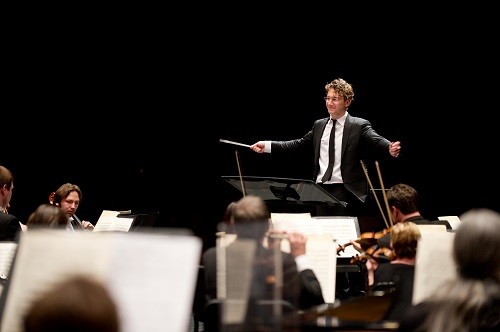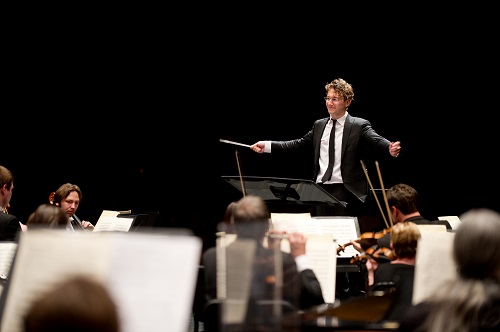 United States Norman, A Trip to the Moon & Holst, The Planets: Soloists, Chorus and Orchestra of Los Angeles Philharmonic, Los Angeles Master Chorale, Los Angeles Children’s Chorus, Hoover Street Elementary Chorus, Members of Youth Orchestra Los Angeles / Teddy Abrams (conductor). Disney Hall, Los Angeles, 2.3.2018. (JRo)
United States Norman, A Trip to the Moon & Holst, The Planets: Soloists, Chorus and Orchestra of Los Angeles Philharmonic, Los Angeles Master Chorale, Los Angeles Children’s Chorus, Hoover Street Elementary Chorus, Members of Youth Orchestra Los Angeles / Teddy Abrams (conductor). Disney Hall, Los Angeles, 2.3.2018. (JRo)

Cast:
Georges Méliès – Peter Tantsits
Eoa – Lauren Snouffer
Queen of the Moon People – Eve Gigliotti
Moon Man – Theo Hoffman
Professor Barbenfouillis – Clayton Farris
Nostradamus – Todd Strange
Alcofrisbas – Kalean Ung
Omega – Jon Lee Keenan
Micromegas – James Hayden
Parafaragaramus – Carolyn Michelle Smith
Production:
Director – Yuval Sharon
Choreographer & Associate director – Diana Wyenn
Set Design – Takeshi Kata
Lighting design – Christopher Kuhl
Video design – Jason H. Thompson & Kaitlyn Pietras
Sound Design – Mark Grey
Costume Design – Ann Closs-Farley
Artistic Director/LA Master Chorale – Grant Gershon
Artistic Director/LA Children’s Chorus – Anne Tomlinson
Music Director/Hoover Street School Chorus – Paula Ludwig
Sincere, vivacious and message driven, Andrew Norman’s 50-minute children’s opera, A Trip to the Moon, is not without its charms. I’m fairly certain the 7000 Southern California elementary school children who will see it next week as part of the LA Philharmonic’s Symphonies for Schools will enjoy the experience. With the LA Children’s Chorus and Hoover Street Elementary School Chorus adding their voices to the Los Angeles Master Chorale, there’s no shortage of youthful enthusiasm. Add to that the fascinating percussion instruments for children to feast their ears and eyes on – boomwhackers, tam-tam, tin cans, bongos, thunder tubes and cymbals – and you have one rollicking party.
Does it join the ranks of child-friendly operas that endure like Humperdinck’s Hansel and Gretel, Knussen’s Where the Wild Things Are and Higglety Pigglety Pop!, Ravel’s L’Enfant et les Sortilèges, Menotti’s Amahl and the Night Visitors or (my personal favorite for kids) The Magic Flute? Time will answer that question, but at the moment I feel essential ingredients are missing to insure its future success.
The concept, based on pioneer filmmaker Georges Méliès famous short film, A Trip to the Moon, was an inspired idea. Unfortunately, it felt undeveloped in any substantive way, whether for adults or children. In 1902, Méliès, at the forefront of technological advances in film, produced an exotic creation of man’s first encounter with a civilization on the moon. Projecting the film on a large screen at Disney Hall, Norman composed effective instrumental music to accompany the first few scenes showing the gathering of the astronomers, the building of a rocket and the moon launch. Once the rocket fires, live actors and singers were introduced who, through the use of two green screen panels, were interposed in real time onto the film. Action proceeded within the film and in front of the screen as Méliès himself became a character, and his crew and team of actors landed on the moon and interacted with its inhabitants.
The plot, as derived from the film, seems to imply that rather than create his movie in the studio, Georges (as he is called in the opera) took the cast to the moon in order to shoot on site. The movie actor cast has only spoken roles. The singing roles belong to Georges, Eoa (a moon girl), the Queen of the Moon People and Moon Man.
Action occurred on a platform above the orchestra with minimal scenery – a few crudely painted rocks indicated the surface of the moon and referred to the film’s scenery. As usual, the hall was unkind to dramatic performance, which invariably feels cramped in the allotted space that Gehry’s design has to offer.
The moon language, a singing cascade of vowel sounds, had a certain allure that held up remarkably well but grew tiresome towards the end. A give-and-take between Georges and Eoa, who spend much of the opera exchanging and learning their two languages, formed the basis of a number of duets and promoted the ideal of tolerance and mutual understanding. This message was not enough to carry the opera, however. With its simplistic plot and retro nod to the original film, an opportunity was missed to address the magnificent achievements in art, technology and industry that occurred at the beginning of the twentieth century. Though Norman’s music was forward thinking, his libretto was stuck in a trite version of the past.
Ann Closs-Farley’s costumes were also retro, referring vaguely to such 1920s film classics as Aelita Queen of Mars and Metropolis. Unfortunately, they didn’t have enough polish to make the space characters appear to be more than benign angels. The hall was awash with the children’s chorus in silver drapery, topped with lighted halos. The actors sported tweeds and boots, and the monster (not seen in the film) was an onscreen animated rock creature whose likeness has been seen a thousand times in film and television.
Artist-in-Residence Yuval Sharon managed to keep the on-stage singers and actors and the seated chorus in order, but when some of the participants took to twirling thunder tubes in various locations around the hall, the effect was distracting and chaotic.
More structure was needed to organize the unfolding action, and the man who successfully supplied structure at the podium was Teddy Abrams, the vigorous music director of the Louisville Orchestra and the Britt Orchestra. Abrams kept all the elements of Norman’s percussive score in balance. From lyrical phrases to explosive crescendos, from ethereal flutes to earthly tuba, and from the haunting phrases of the soprano’s vowel laden solos to the cacophonous bellowing of the chorus when a moon child was snatched by the rock monster, Abrams lovingly guided Norman’s creation.
As Queen of the Moon People, mezzo Eve Gigliotti had the vocal depth to add gravitas to the production. Peter Tantsits as Georges Méliès sang with a rich tenor, anchoring the piece dramatically, and Lauren Snouffer’s Eoa created the pure, lithe tone needed to portray an otherworldly creature. Theo Hoffman’s Moon Man added the right vocal counterpoint with his resonant baritone.
The second half of the evening consisted of Gustav Holst’s The Planets, which held me in its celestial embrace like a familiar friend. Abrams amassed all the spirited forces of the superb LA Phil to produce the mythic intensity of Mars, the sensuality of Venus and the quicksilver sounds of Mercury as the trickster god trips across the universe in a shivering of strings and a chattering of flutes and piccolos. Particularly illuminating was the carnivalesque sound of Uranus – with snatches reminding me of John Walter Bratton’s 1907 tune, ‘Teddy Bear’s Picnic’ (though on steroids). With the Los Angeles Master Chorale’s women’s chorus offstage bringing ‘Neptune, the Mystic’ to a mysterious close, it proved an altogether satisfying finale to an evening among the stars.
Jane Rosenberg
